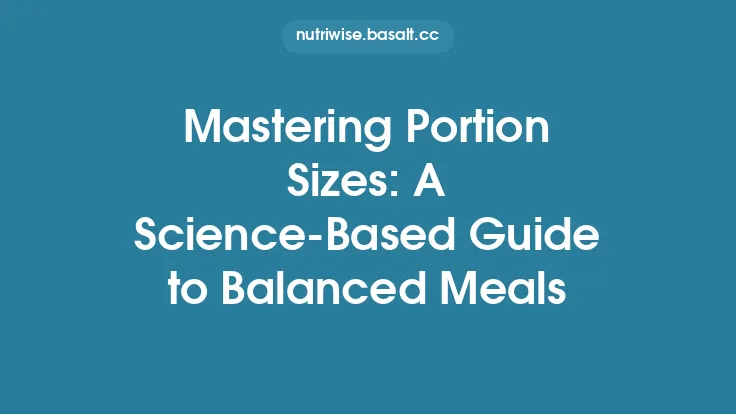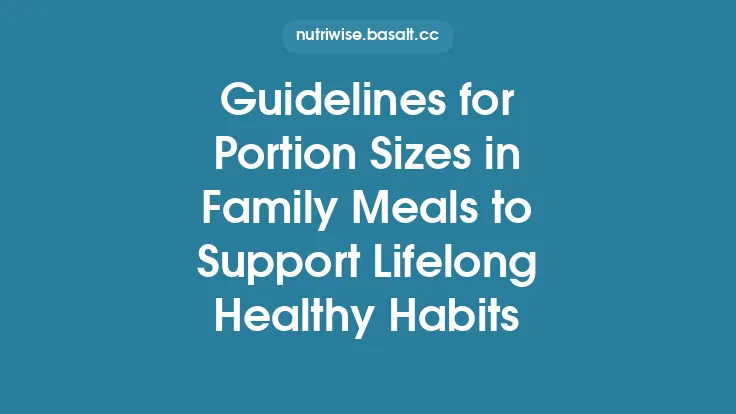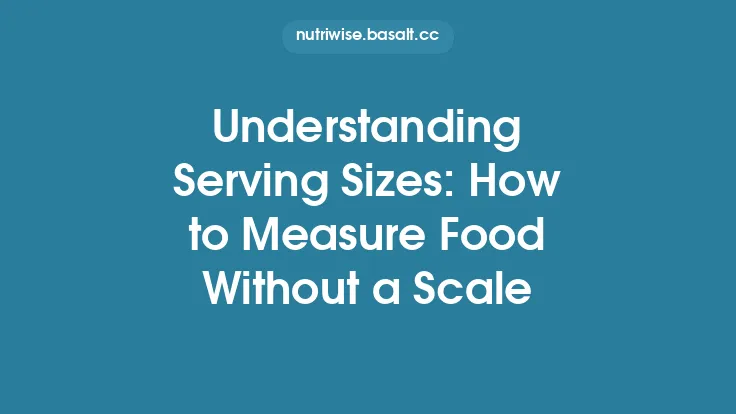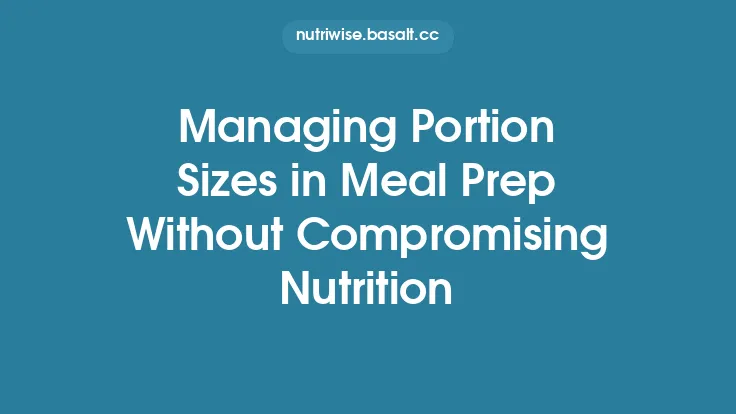Caloric density—sometimes called energy density—is a fundamental concept that helps us understand why two foods that look similar on the plate can deliver very different amounts of energy. Grasping this idea equips anyone who prepares meals, plans menus, or simply wants to make more informed food choices with a practical lens for judging how much of a given item should be served. Below, we explore the science behind caloric density, the factors that shape it, and how to translate that knowledge into smarter portion decisions without venturing into weight‑loss or satiety‑focused strategies.
Defining Caloric Density
Caloric density describes the amount of energy (measured in kilocalories, kcal) contained in a specific weight or volume of food. It is most commonly expressed as:
- kcal per gram (kcal/g)
- kcal per 100 g (useful for comparing packaged foods)
- kcal per cup or other volume unit (helpful for liquids and bulk items)
For example, a raw carrot provides roughly 0.4 kcal/g, whereas a tablespoon of olive oil delivers about 9 kcal/g. The same weight of each food therefore supplies dramatically different energy amounts.
Determinants of Caloric Density
Several intrinsic and extrinsic factors dictate a food’s caloric density:
| Factor | How It Affects Density |
|---|---|
| Macronutrient composition | Fat supplies ~9 kcal/g, while protein and carbohydrate each provide ~4 kcal/g. Foods high in fat naturally have higher density. |
| Water content | Water contributes no calories but adds mass, diluting the energy per gram. High‑water foods (e.g., soups, fruits) are low‑density. |
| Fiber and non‑digestible carbohydrates | These add bulk without contributing fully digestible calories, lowering overall density. |
| Air incorporation | Whipped or aerated foods (e.g., mousse, soufflé) contain pockets of air, reducing mass per unit volume and thus density. |
| Cooking and processing | Methods that remove water (dry‑roasting, dehydration) concentrate calories, while those that add water (boiling, stewing) dilute them. |
Understanding these variables clarifies why the same ingredient can shift dramatically in density depending on preparation.
Calculating Caloric Density
The calculation itself is straightforward:
\[
\text{Caloric Density (kcal/g)} = \frac{\text{Total Calories (kcal)}}{\text{Weight (g)}}
\]
Step‑by‑step example
A serving of cooked quinoa provides 222 kcal and weighs 185 g.
\[
\frac{222\ \text{kcal}}{185\ \text{g}} \approx 1.20\ \text{kcal/g}
\]
If you need the density per 100 g, multiply by 100:
\[
1.20\ \text{kcal/g} \times 100 = 120\ \text{kcal/100 g}
\]
When nutrition facts are presented per “serving,” simply convert the serving size to grams (or milliliters for liquids) and apply the formula. For homemade dishes, sum the calories of each ingredient, total the weight, and compute the overall density.
Interpreting Caloric Density Across Food Groups
| Food Group | Typical Caloric Density (kcal/100 g) | Representative Examples |
|---|---|---|
| Non‑starchy vegetables | 10–30 | Lettuce, cucumber, broccoli |
| Fruits (high water) | 30–60 | Watermelon, orange, apple |
| Starchy vegetables & grains | 80–120 | Sweet potato, brown rice, oats |
| Legumes | 110–130 | Lentils, chickpeas |
| Lean proteins (cooked) | 120–150 | Skinless chicken breast, tofu |
| High‑fat proteins | 200–250 | Salmon, pork shoulder |
| Nuts & seeds | 560–650 | Almonds, chia seeds |
| Added fats & oils | 880–900 | Olive oil, butter |
| Processed snacks | 450–550 | Potato chips, granola bars |
These ranges illustrate that even within a single category (e.g., proteins), density can vary widely based on fat content and preparation.
Applying Caloric Density to Portion Decisions
Instead of relying on generic “one‑cup” or “one‑handful” rules, consider the following mental model:
- Identify the density tier – low, moderate, or high.
- Set a target energy contribution for the component of the meal (e.g., “I want this side to provide roughly 150 kcal”).
- Adjust the weight accordingly using the density value.
Illustrative scenario
You plan a side dish of roasted carrots and want it to contribute about 150 kcal.
- Raw carrots: ~0.4 kcal/g
- After roasting (water loss ≈ 20 %): density rises to ~0.5 kcal/g
Required weight = 150 kcal ÷ 0.5 kcal/g = 300 g of roasted carrots.
By scaling the weight based on the measured or estimated density, you achieve a precise energy contribution without guessing portion size.
Ingredient Substitutions to Modify Caloric Density
When a recipe calls for a high‑density component but you wish to lower the overall energy load, consider these swaps that preserve texture and flavor:
| Original Ingredient | Approx. Density (kcal/g) | Substitute | Approx. Density (kcal/g) | Functional Note |
|---|---|---|---|---|
| Butter (7.2) | 7.2 | Unsweetened applesauce (0.5) | Reduces density dramatically; works in baked goods for moisture | |
| Heavy cream (3.2) | 3.2 | Greek yogurt (0.9) | Maintains creaminess with lower density | |
| White rice (1.3) | 1.3 | Cauliflower rice (0.2) | Provides bulk with minimal calories | |
| Ground beef (2.5) | 2.5 | Ground turkey (1.5) | Lowers density while keeping protein profile | |
| Cheddar cheese (4.0) | 4.0 | Nutritional yeast (2.5) | Adds umami flavor with reduced density |
These exchanges illustrate how a modest change in ingredient choice can shift the caloric density of an entire dish.
Culinary Techniques That Influence Caloric Density
Beyond ingredient selection, cooking methods can raise or lower density:
- Hydration‑heavy methods (boiling, steaming, poaching) increase water content, lowering density. Example: simmered beans absorb water, reducing kcal/g.
- Dry‑heat techniques (roasting, grilling, sautéing) often evaporate water, concentrating calories. Example: roasted nuts become denser than raw.
- Emulsification (making vinaigrette) disperses oil in water, creating a mixture where the overall density is a weighted average of its components.
- Aeration (whipping egg whites, incorporating leavening agents) introduces air, decreasing mass per volume and thus density.
Being aware of these effects enables you to intentionally design dishes with the desired energy concentration.
Nutrient Quality Considerations
Caloric density alone does not convey the full nutritional picture. A food can be low‑density yet nutrient‑poor (e.g., sugary beverages) or high‑density yet nutrient‑rich (e.g., nuts). To balance energy and micronutrients:
- Pair low‑density foods with high‑density, nutrient‑dense items (e.g., a salad topped with a modest portion of avocado).
- Assess “nutrient density”—the ratio of essential vitamins, minerals, and phytonutrients to calories. Foods scoring high on both nutrient and caloric density (e.g., fatty fish) can be valuable components of a diet.
- Mind the fiber-to-calorie ratio; higher fiber often means lower caloric density and added health benefits.
Integrating both concepts ensures that portion decisions support overall dietary quality.
Common Misconceptions
| Misconception | Reality |
|---|---|
| “Low‑calorie foods are always the healthiest.” | Low density can stem from added sugars or refined starches that provide empty calories. Evaluate nutrient content alongside density. |
| “High‑calorie foods are inherently bad.” | Foods like olive oil, nuts, and seeds are dense but supply essential fatty acids, antioxidants, and satiety‑supporting fats. |
| “All foods of the same weight have the same energy.” | Water, fiber, and air dramatically alter the energy per gram. |
| “Cooking always reduces calories.” | Some methods (e.g., drying, frying) concentrate calories, while others (e.g., boiling) can dilute them. |
Clarifying these points prevents oversimplified judgments based solely on caloric density.
Integrating Caloric Density Knowledge Into Meal Planning
A practical workflow for using caloric density in everyday meal design:
- Catalog staple ingredients with their approximate densities (keep a quick reference sheet or digital note).
- Define the energy target for each meal component (e.g., “main protein ~250 kcal, side vegetables ~80 kcal”).
- Select foods whose densities align with those targets, then calculate the required weight.
- Adjust cooking methods to fine‑tune density (add broth to increase volume, roast to concentrate).
- Review nutrient profile to ensure the final plate meets macro‑ and micronutrient goals.
Sample menu illustration
| Component | Chosen Food | Density (kcal/100 g) | Desired kcal | Required weight |
|---|---|---|---|---|
| Protein | Skinless chicken breast (cooked) | 150 | 300 | 200 g |
| Starch | Quinoa (cooked) | 120 | 180 | 150 g |
| Vegetable | Steamed broccoli | 35 | 70 | 200 g |
| Fat | Olive oil (drizzled) | 884 | 120 | 13.5 g |
By anchoring each portion to a specific caloric contribution, the overall meal delivers a balanced energy distribution without relying on vague portion heuristics.
Key Takeaways
- Caloric density quantifies energy per unit weight or volume, shaped by macronutrient makeup, water, fiber, and preparation.
- Simple calculations let you translate density into precise portion weights for any target calorie amount.
- Ingredient swaps and cooking techniques provide practical levers to raise or lower a dish’s density while preserving culinary intent.
- Nutrient quality matters; combine density awareness with assessments of vitamins, minerals, and fiber.
- Avoid common myths that equate low density with health or high density with poor nutrition.
- Apply a systematic approach—reference densities, set energy targets, compute weights, and verify nutrient balance—to embed caloric density insight into everyday meal planning.
Understanding and leveraging caloric density equips you with a clear, quantitative framework for deciding “how much” of each food to serve, fostering meals that are both energetically appropriate and nutritionally robust.





